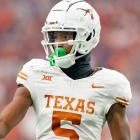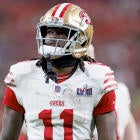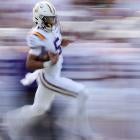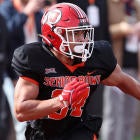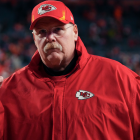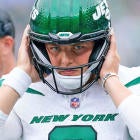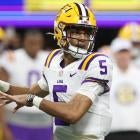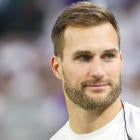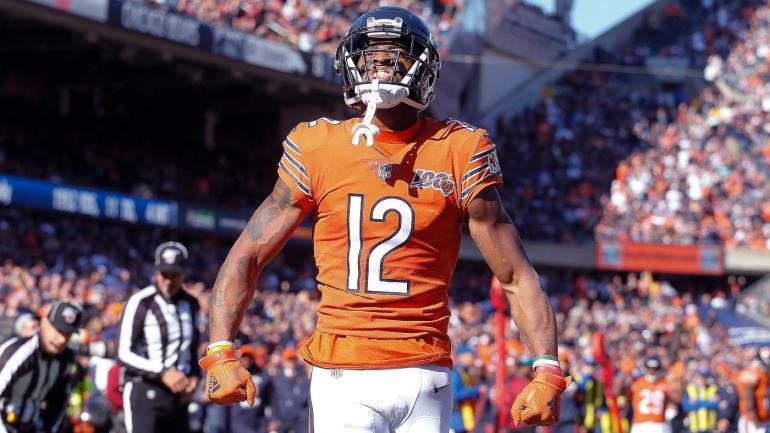
"I want to feel like when we walk off the field after the last game, whenever that is, that we have the pieces in place to compete for a Super Bowl," Giants owner John Mara said in early September, via The Post. Even the staunchest supporters of New York's general manager Dave Gettleman couldn't look you straight in the eye and tell you this roster has the pieces in place to compete for a Super Bowl after winning six games -- four against the worst division in NFL history and one against the Joe Burrow-less Bengals. However, that doesn't mean the Giants can't make a big leap forward in 2021. And you shouldn't lose all hope as rebuilds can come together fast.
Contrary to what some fans of the current regime will tell you, rebuilds don't have to take four-plus years. Not even two years ago, the Miami Dolphins were accused of tanking and this year they nearly made the playoffs and had a winning season. The 49ers went from almost acquiring the first overall pick to representing the NFC in the Super Bowl. The Browns were a combined 1-31 (this is not a typo) prior to the 2018 draft and now they've made the playoffs with 10 wins in a loaded AFC. These are just three recent examples, but they aren't the only ones.
If the Giants want to make that leap, they're going to need to make some key changes during the 2021 offseason. We've put together a five-step plan to fix the Giants in 2021. Since we're well aware a John Mara-run franchise is not likely to make this much change in just one offseason, we've ranked the steps in order of importance based on a combination of factors, but namely, the countless hours we've poured into studying the All-22 coaches film of this 2020 roster. Without further ado, let's dive right in.
Step 1: Upgrade the offensive system
If you asked me the best way to improve the Giants on a long-term basis, I would probably point to Step 2, but to fix this team in 2021, they are going to have to change offensive systems and offensive play-callers. For starters, current OC Jason Garrett's offensive system is a poor fit for QB Daniel Jones' skill set. In his rookie season, Jones racked up a 24:12 TD to INT ratio in Pat Shurmur's system. A few key reasons Jones was successful include a heavier dosage of 11 personnel, shotgun formations, mesh concepts to defeat both man and zone coverages, and half-field hi-low reads that allowed vertical routes to come open in Jones' processing much faster.
In Garrett's system, the Giants have essentially taken a trip back through time. Garrett features several heavy personnel packages featuring 13 and 21 personnel at times -- with eight players on the line of scrimmage -- or an h-back lined up in backfield. When it works, the Giants control the clock, move the chains and grind out wins in conjunction with their defense's performance. When it doesn't work, the spacing is terrible, receivers run routes on top of each other and at the same depth (too often right at the sticks) and the offense bogs down in field goal range or worse. More often than not, the offense didn't work in 2020 when the Giants finished 31st in scoring and 20-plus-yard plays -- ahead of only the lowly Jets.
There's also the issue of Garrett finishing in the top 10 among all play callers when it comes to the single worst decision a play caller can make -- calling a run on second-and-long.
Which teams were best at avoiding rush attempts in the worst time to rush? (2nd & long) pic.twitter.com/aMFR0HWNA0
— Computer Cowboy (@benbbaldwin) January 4, 2021
There are several variations of short and intermediate passes and screen passes that can operate in place of your run game on second-and-long with a much higher efficiency. The vast majority of 20-plus plays -- the ones that ultimately decide football games (in conjunction with red zone passing efficiency) come via the passing game. On second-and-long, a passing play also gives the offense an opportunity to create a chunk yardage play and potentially a touchdown. By running so often on second-and-long, Garrett put the Giants offense in far too many third-and-long situations.
Between his unimaginative route combinations and concepts, his lack of shotgun and 11 personnel (which both mesh much better with Jones' skill set), his tendency to run on second-and-long and his poor red-zone play calling, Garrett was as big of a factor as any for the Giants' 31st-ranked offense in 2020. And you can go ahead and throw out the continuity argument considering Jones and the offense performed at a considerably higher level in a 2019 -- in a new system as well -- with a considerably less consistent offensive line.
This one is a no brainer and the most important change the Giants must make this offseason.
Step 2: Pay up for a top-tier free agent, plus mid-level depth
It's uncertain which projected free agents will ultimately hit the market after re-signings and franchise tags, so we won't play that guessing game now -- at least not entirely. However, with former Gettleman draft picks like Curtis Samuel (WR) and Taylor Moton (OT) set to hit the market after breakout seasons with the Panthers, and both at positions of need, they'll certainly be on the Giants' radar as they should be.
If he hits the market, Bears receiver Allen Robinson should likely be the Giants' No. 1 free agent target. Robinson has been held back by poor QB play his entire career, but he might be the best contested-catch receiver -- save for DeAndre Hopkins -- as well as one of the 10 best route runners. His skill set is also a perfect fit for what Daniel Jones does best and most frequently as a passer. Think of how many contested vertical routes Giants receivers didn't come down with in 2020? Robinson can fix that immediately.
Only WRs w/ 150+ targets and 1 drop in a season since 2006
— PFF Fantasy Football (@PFF_Fantasy) January 4, 2021
🔹 Allen Robinson ('20)
🔹 DeAndre Hopkins ('20)
🔹 Antonio Brown ('18) pic.twitter.com/0YtLN5JYTn
The Giants need to fill out their depth with mid-level signings at the shallowest positions (edge rusher, inside linebacker, cornerback, offensive tackle, running back), but they also need to get aggressive at the top and a receiver like Robinson is a perfect match.
Before you mention "projected cap" as if it's some kind of hard number, just look at the roster's contracts past 2021. Besides LB1 (Blake Martinez), CB1 (James Bradberry), S1 (Logan Ryan) and soon-to-be DL1 (Leonard Williams), the Giants have no massive deals likely to be on the books past the 2021 season. And three of those are in the $10M-per-year range -- fitting more into the mid-tier pricing range -- alongside Sterling Shepard, Andrew Thomas and Saquon Barkley on the offensive side.
Also, the "projected cap" number you see from sources who track it is not what the Giants use anyway. Any team can create more (or less) cap space by dipping year(s) into the future. The Giants are fortunate enough to have Kevin Abrams employed to work their salary cap and he has done a masterful job with it. The bottom line is this: With Jones still on his rookie deal, now is the time to get aggressive in free agency.
Step 3: Upgrade CB2 to open up Graham's D
The Giants opened Week 1 against the Steelers with a man-coverage-heavy game plan. After all, man coverage was a staple for first-year Giants defensive coordinator Patrick Graham during his 2019 season as Dolphins coordinator. After one week of watching a rusty Ben Roethlisberger carve up whoever Graham tried at the other boundary cornerback position opposite Bradberry, he reshaped his entire plan moving forward to feature a zone-based defense. The Giants then cycled through four different cornerbacks on the boundary opposite Bradberry throughout 2020 including Corey Ballentine (since cut), Ryan Lewis, Isaac Yiadom and finally during the last two weeks of the season Julian Love.
While it was a small sample size, Love showed the most to me, but there are question marks there about his ability to hold up in man coverage. If the Giants can find a cornerback who can hold up consistently in man coverage, it will allow what was already the Giants' best coordinator hire (on either side of the ball) since Steve Spagnuolo to get even more creative in his system.
If the Giants don't go the big-time WR route in free agency, a free agent CB like William Jackson should be on their radar. When they select at No. 11 overall in the 2021 NFL Draft, several CB prospects including Patrick Surtain II, Caleb Farley and Jaycee Horn should also be on their radar.
Graham proved he can manufacture pressure despite losing his top three EDGE rushers to injury. Gift him another shutdown CB and watch him take this defense from pretty darn good to elite.
Step 4: Improve the draft process
It shouldn't take much to convince you that the draft is an imperfect process as each class is littered with examples of perennial All-Pro players who were selected sometimes hundreds of selections after busts. The imperfect draft process will come even more into play during the pandemic with dozens of top prospects opting out, front offices unable to travel as often to scout players, and less information on the prospects than ever before. If you accept that the draft is an imperfect process, it's easy to see why having more picks gives your roster a better chance of succeeding.
The Colts are a great example of this process playing out successfully. When current GM Chris Ballard took over, he had to rebuild the Colts roster. Ballard immediately displayed his understanding of the draft process during the 2018 NFL Draft when the Colts selected one pick after the Giants at No. 3 overall and parlayed that pick into No. 6 overall and three early second-round picks. That trade has played a big role in creating a winning roster in spite of shaky QB play over the last two seasons with Jacoby Brissett and Philip Rivers on his last legs.
However, it's not an outlier. In every draft, Ballard has maneuvered to have a plethora of picks to take chances on and it's one of the reasons the Colts have one of the deepest rosters in the NFL -- one that withstood numerous injuries in 2020 and still battled through to an 11-5 record. Here's a snapshot of Ballard's draft classes:
If you just remove the 2nd round of 2019 Chris Ballard is the greatest drafter alive pic.twitter.com/MKLsdR2584
— Benjamin Solak (@BenjaminSolak) December 23, 2020
Under Gettleman, the Giants have taken the opposite approach. They have never traded to acquire more draft picks during the draft and have instead traded up (to acquire DeAndre Baker). Gettleman has also mentioned on multiple occasions (Will Hernandez, Xavier McKinney, Lorenzo Carter) that he was tempted and nearly pulled the trigger on trading more picks to acquire these prospects before they ultimately fell anyway to the Giants' respective picks.
In addition to not trading to acquire more picks, Gettleman has a tendency to fall in love with prospects after using his own two eyes to evaluate their game film and after meeting and speaking with them. He infamously referred to Saquon Barkley as having "been touched by the hand of God" and also told Giants beat reporters he fell in "full bloom love" with Daniel Jones -- a QB prospect most scouts had a late one or early second-round grade on.
Thinking you can outsmart the other 31 GMs from a talent evaluation standpoint is not a tried and true practice and something the Giants need to do a lot less of no matter who is in charge. This team lacks depth at every single position besides safety and interior defensive line and they need more draft picks to address it.
Step 5: Move on from Gettleman, defer more to Judge
When I first started writing this, it was before multiple Giants beats (The Post, SNY) reported Gettleman will get another chance in 2021 -- hence the strike-through. So instead, we'll move it down the list and call for coach Joe Judge -- who hails from the Patriots way -- to take an even bigger role in molding the roster moving forward. The optimal play was to bring in an outside general manager who -- during the interview process -- was convincing he would bring an improved draft process and a greater focus on passing the football and stopping the pass.
Those two concepts were described as tenets of Gettleman's blueprint by Dave himself when he was hired, but the best teams view them as luxuries. The two tenets for building a successful football team in 2021 are passing the football and stopping the pass. The hope is that the Giants took a step in that direction during the 2020 NFL Draft -- deferring more to players who can protect the passer (Andrew Thomas, Matt Peart) and stop the pass (Xavier McKinney, Darnay Holmes). This was a step in the right direction from a roster-building standpoint.
As we get set to embark on year four of Gettleman's regime, but also year two of Judge's stay, let's hope the roster continues to mold itself more in the coach's image.














